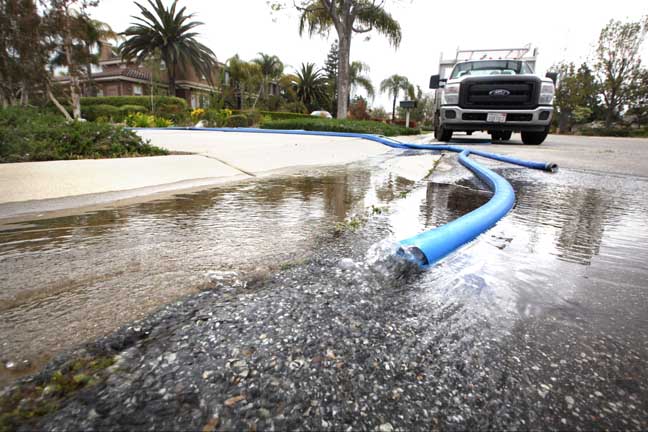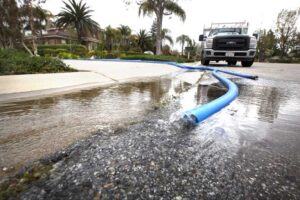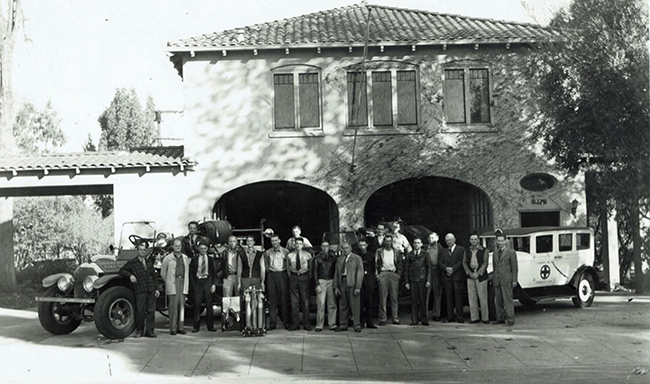Groundwater still flooding north Claremont homes

Ken Larsen has set up eight pumps to siphon off the groundwater seeping onto his north Claremont property. Courier photo/Steven Felschundneff
by Steven Felschundneff | steven@claremont-courier.com
On Easter Sunday, Ken Larsen first noticed water collecting on his pool deck and assumed he had a burst pipe, which is never good. But the water kept pooling, literally coming straight out of the ground, and before long it was flowing into his pool and flooding the lawn. It was then that he realized the problem was much bigger than faulty plumbing.
Larsen, who lives on New Hampshire Avenue, would soon learn he was far from alone. On April 6, the first reports of water emerging from the ground came from residents on Appalachian and Nashotah streets in the Stone Canyon development. All told, the mysterious flooding has affected some three dozen homes adjacent to Padua Avenue and Mt. Baldy Road in the northeastern part of Claremont.
On Wednesday the water had been flowing for 10 days with no end in sight.
Larsen has set up a series of pumps with an intricate maze of hoses designed to get the rapidly collecting water out of his yard and to the street where it flows into a storm drain. He also dug a series of canals to divert the water away from his home and pool deck. When reached by phone Tuesday, Larsen was buying yet another pump, bringing the total at his home to eight.

Ken Larsen has set up eight pumps to siphon off the groundwater seeping onto his north Claremont property. Courier photo/Steven Felschundneff
“The sad thing is we have some neighbors who can’t do what I can, so I have been helping them,” Larsen said. “The help we got from the city? Free sandbags at the sports park.”
Larsen fears the water has created caverns under his concrete pool deck which could cause it to collapse once everything dries out. Based on his experience as a construction contractor, he estimates the repairs could reach $100,000, and the repair bill would come out of his pocket because he does not have flood insurance.
So, what exactly is happening? On Wednesday, Chris Diggs, president of the Six Basins Watermaster Board, said many of the factors behind the flooding remain unknown, but there are several established facts.
According to Diggs, the homes in Stone Canyon are located in an area that has historically experienced shallow groundwater conditions. In addition, the bedrock is only 60 feet below the surface in Stone Canyon, so the soil on top of that rock is relatively shallow and will reach its carrying capacity of water relatively quickly. But perhaps the most important factor is the unusually heavy rainfall this winter.
“Where groundwater conditions are as shallow as they are beneath the Stone Canyon neighborhood, the ground has less capacity to absorb water during and after heavy rainfall events and groundwater levels may later rise quickly as a result,” Six Basins Watermaster and Pomona Valley Protective Association officials said in a joint statement.
Diggs said the rainfall this winter was the second highest ever recorded in the region. As a result, water has been flowing from three different locations in the hillside directly above and north of the Stone Canyon neighborhood. The only year when the region saw more rain was 2005, before the Stone Canyon homes were built.
“A significant amount of the groundwater impacting homes in the Stone Canyon area is likely coming from the saturated hillside,” according to the joint statement.
But some residents, including Larsen, fear the true culprit behind the flooding may be the large amount of water recently released through the San Antonio Dam’s floodgates.
The Army Corps of Engineers, which owns and maintains the dam, recorded a 20-foot drop in the water level behind the dam during a 15-day period earlier this month, according to a letter sent from Claremont officials to homeowners in the affected area.
The water being released does not simply flow out to the ocean but is retained in a series of catch basins on Pomona Valley Protective Association land, including several pools near Stone Canyon. The process is overseen by Six Basins Watermaster and is an integral part of groundwater recharging, which is particularly important now given the yearslong drought.
Six Basins officials said the organization had modified spreading operations away from the pools near Stone Canyon “out of an abundance of caution” and water was now being directed to catch basins further south.
“The Watermaster and PVPA will continue to monitor and evaluate the situation,” read the joint statement.
“Our field staff is reporting that the lower two [Pomona Valley Protective Association] basins are drying up, showing small amounts of water,” City of Claremont Public Information Officer Bevin Handel wrote in an email on Tuesday. “The water has subsided noticeably on Stone Canyon, north of Mount Baldy, and east of Padua. The Appalachian residences west of Padua at the end of the cul de sac remain unchanged. Residences on Moody (on north side, backing to Mount Baldy) are showing reduced water pressure and flow. It appears that the flow on New Hampshire (south side) is subsiding (according to residents’ reports).”
The diversion of runoff from the dam appears to be working, according to Larsen, who reports the flooding has stopped for residents on higher ground. He is hopeful this is a good sign for him as well as his lower elevation neighbors who still have significant flows.
Diggs said there is no evidence that the diversion away from the pools near Stone Canyon is the reason flooding has stopped for some residents. He said it’s more likely the hillside is simply drying out as it naturally would at the end of the rainy season. As evidence, he cited three waterfalls off of Mt. Baldy Road between Evey Canyon and Shinn Road that were flowing just a few weeks ago which have now dried up or been reduced to just a trickle.
Six Basins Watermaster was created in 1998 as part of a court settlement over the rights of local providers, including Golden State Water Company, that depend on water drawn from the aquifer. It manages the water retention activities across the “six basins” stretching from San Antonio Heights across Claremont to northern Pomona and portions of La Verne.
The Pomona Valley Protective Association is a century-old non-profit that, under the direction of Six Basins officials, is tasked with spreading water collected from San Antonio Creek.
People who live in San Antonio Heights, Claremont, Upland, Pomona, and La Verne depend on this groundwater to keep our taps flowing and reduce the water supplies we import from Northern California and the Colorado River.










0 Comments